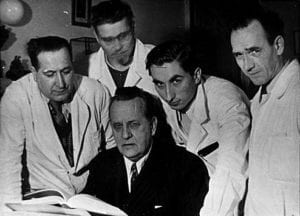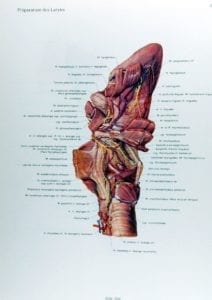Irving Rosen
Toronto, Ontario, Canada

Bauer typical of his golden women portraits. This portrait
was seized and renamed by Hitler as Lady in Gold
Vienna, capital of the former Austro-Hungarian Empire, has always promised intellectual fervor, Strauss waltzes, Schnitzlerian flirtations, Sachertorte, and the beautiful golden women painted by Gustav Klimt (fig. 1).1 Others such as Eduard Pernkopf, head of anatomy at Vienna’s renowned medical school, achieved artistic brilliance by creating a beautiful, internationally acclaimed atlas of anatomy. Assisted by four artist illustrators, his atlas showed a topographic view of human anatomy similar to that of Canada’s Boileau Grant.2 Unlike Dr. Grant, however, Pernkopf (fig. 2) and associates were unapologetic, die-hard Nazis whose anatomical atlas included swastikas and SS thunderbolts expunged after World War II.3
With charismatic Hitler’s assumption of what soon became absolute power, doctors were anxious to join the Nazis.4 The German Medical Association’s Dr. Stauber wrote Hitler, “The association welcomes with the greatest joy the determination of the Third Reich.” The Prussian Chamber of Physicians declared a “readiness to place its energies and experience at the service of the Nazi regime . . . the democratic Weimar Republic has passed into history.” Specialty groups followed suit. Fifty percent of doctors joined the Nazis and seven percent became members of the murderous SS. Social Darwinism and eugenics—conceived by Darwin’s cousin Sir Francis Galton (1882-1911)—were used by Nazis to fashion hard laws of euthanasia, sterilization, and elimination of non-Aryans.5 Doctors, having silently witnessed the removal of non-Aryan i.e. Jewish colleagues, accepted Nazi laws without hesitation.6 Inured to human suffering, pain, and death, they complied without compulsion and became integral to the Nazi Death Machine. They devised and administered the T4 scheme where children and adults “having a life not worth living” were certified to die in luminal or gas vans. Doctors stood at lager rail ramps, selecting inmates for death or life, carrying out brutal experiments on trauma, cold exposure, water immersion, infection, twin behavior, and sterilization, killing inmates thereby gaining financial gain. Top doctors were involved, such as the thoracotomy innovator Dr. Ferdinand Sauerbruch, who later defended his actions by invoking fear of the Gestapo. Nazi doctors’ “scientific” work accomplished little if anything, especially compared to those expelled who became Nobel laureates such as Krebs, Chain, Kandel, and Loewi.

assistants, all bone-fide Nazis who produced the remarkable
Topogrphishe Anatomie des Menschen
Dr. Eduard Pernkopf was a Nazi who studied the dead but did not cause their death.3, 7 Born in Austria in 1888, where his father was a small-town physician, and, mindful of family need, young Pernkopf set aside his love of music and entered the University of Vienna Medical School in 1907. Emperor Franz Joseph then ruled Austro-Hungary and his plan for multiethnic tranquility was contested by Vienna’s popular racist mayor, Karl Lueger (1894-1916), whose public racist hate rants were heard by many, including the failed artist Adolf Hitler. Pernkopf belonged to a nationalistic pan-German student fraternity, graduating in 1912 and serving in the army for one year in World War I. Interested in a career in anatomy, he attached himself to the university’s head of anatomy, Dr. Frederich Hochstetter, and became a professor in 1928. In 1933 he started work on his atlas, succeeded Hochstetter as head of the anatomy department, and joined the then-outlawed Austrian Nazi Party, followed by membership in the SA Sturmabteilungen Brownshirts. In 1938 Hitler annexed Austria, welcomed by the Austrian people, some of whom witnessed the cruel humiliation of non-Aryan fellow citizens scouring the streets of Vienna on their knees.
Pernkopf was then appointed dean of the medical school and demanded his staff show medically certified Aryan identity and swear an oath of loyalty to Hitler. He summoned his staff to declare policy, subsequently published in Wiener Klinische Wochenshrift (WKW), saying: “To assume the medical care with all your professional skill of the body of the people, only in the positive sense of furthering the propagation of the fit but also in the negative of eliminating the unfit and defective . . . by the exclusion of the genetically inferior from future generations by sterilization and other means.” The meeting ended with a triple sieg heil by Pernkopf, who then removed 175 non-Aryan medical teachers out of a staff of 190 and organized a new department of race biology. Dr Eppinger, Pernkopf’s crony, wrote that as “all disease has been eradicated, the University of Vienna can address itself to its great task.” (A senior staff member remarked to a group of us touring the Vienna Medical School two decades ago that “the school has not yet recovered.”) Most of the expelled persons went to the US, including Nobel Prize winner Loewi who had to first surrender his Nobel prize money to the Nazis. But some died at Theresienstadt and others committed suicide.
In 1943 Pernkopf became president of the university, the highlight of his career. By 1945 the war was over and Pernkopf attempted to disappear but was caught by the US Army and imprisoned for three years of onerous labor. In 1948 he returned to the Vienna University, dejected and without status or appointment, and was given two small rooms to complete his atlas. By contrast, expellees were discouraged from returning home and lager survivors received no aid in renewing practice or recovering seized assets. In 1955, Pernkopf died of a stroke at age sixty-seven. His former pupil and successor Dr. Heinrich Hayek gave his eulogy, praising Pernkopf as a devoted teacher, scientist, lover, and creator of fine music, avoiding mention of his Nazi past or veneration of Hitler.

showing characteristic details and refined four
color printing
In 1946 the US Army at Salzburg put twenty-three Nazi doctors on trial, resulting in death for seven, acquittal for nine, and jail sentences for seven, which were usually commuted.8 Such a small contingent could not account for the massive misdeeds that were perpetrated. At the war’s end, confused turmoil prevailed, permitting guilty Nazi doctors to escape detection, some coming to North or South America, such as the notorious Dr. Mengele, some soldiering on and eliciting pity when detected as aged, disabled people. Prominent physicians—such as Dr. Otmar Verschauer, a member of the Kaiser Wilhelm Institute in Berlin who awarded Mengele a PhD and received Auschwitz human specimens from him—eluded punishment to head the University of Munster Medical School. The Cold War, the US Operation Paperclip, and the need to renew normal life permitted Nazi doctors guilty of atrocities to escape punishment and resume practice and positions.8 The World Medical Association (WMA) had been organized after the war to assure Nazi doctors’ ethical misbehavior would never recur. But Dr. Hans Sewering (1916-2010), about to become 1992 WMA president, was revealed to be active in the T4 scheme; and withdrew from the presidency, blaming his imbroglio on a Jewish conspiracy while ignoring his own murderous past. Despite these scandalous revelations, Dr. Sewering was still recognized by the German Medical Association for his “valuable work.”
Pernkopf and his assistants, all hateful Nazis, created a remarkable, beautiful atlas of anatomy, an inexplicable act that has stimulated much literature debate about its potential as a medical classic.3, 7 Austria, deceptively and contrary to reality, presented itself as Hitler’s first victim; and Pernkopf’s name was added stealthily to a list of university presidents, enhancing the perception of Austria evading its responsibility. In 1997, Vienna University’s chancellor Vranitzky, responding to external pressure, affirmed the university’s Nazi past and set up an inquiry into “the anatomical sciences.” This revealed that 1,400 bodies of those executed by the Nazis had been made available for the Pernkopf atlas, dismaying unaware users of the atlas and possibly accounting for the current restriction of its publication.3, 10, 11 The list of presidents is housed in a lovely golden shrine evocative of Klimt’s golden women portraits, seized from owners by the Nazis, retained by Austria after the war, and restored to owners’ families only after a bitter, prolonged legal battle waged by an apparently vindictive Austria.12 However, contrary to usual custom, Austrians have currently installed as chancellor thirty-one-year-old Sebastian Kurz, a young political figure who has acknowledged his country’s responsibility and the need to correct past wrongs. Amends notwithstanding, the Pernkopf atlas remains controversial despite the anatomical beauty it portrays so well, because of its connection to a terrible past.
References
- Eileen Kinsella. Art News Jan.2007 .110-15
- Dave Mazierski. Personal communication Jan.20,2018
- David I. Williams. The History of Eduard Pernkopf’s Topographische Anatomie des Menschen. J. Biocommunications 15.2 Spring 1988 2-12
- William Shirer. Rise and Fall of the Third Reich. Simon and Schuster New York 1960
- Phillip K. Wilson Eugenics on-line. Britannica Encyclopedia Dec.20,2018 https://britannica.com/science/eugenics-genetics 1-13
- Robert J. Lifton. The Nazi Doctors Medical Killing and the Psychology of Genocide
Basic Books New York 1986 - Sabina Hildebrandt. How the Pernkopf Controversy Facilitated a Historical and Ethical Analysis of the Anatomical Sciences in Austria and Germany Clin. Anatomy 200719:91-100
- Gail R. Wilensky. Marking the 70th Anniversary of the Doctor’s Trial at Nuremberg. Am J Public Health 108(1) Jan.2018 12-13
- Wendy Lower Willkomen. New York Times. Feb.28 ,2014
- Michael C Atlas Ethics and access to teaching material in the medical library: the case of the Pernkopf atlas. Bull Med Libr Assoc.2001 Jan;89(1)51-58
- Sabina Hildebrandt. Anatomy in the Third Reich. Ann Anat. 2012 194(1)251-66
- Diane Haithman, Christopher Reynolds. Court Awards Nazi Looted Artworks to Los Angeles woman
Los Angeles Times Jan.23,1988
IRVING B ROSEN was born and educated in Toronto Canada. He professionally pursued a practice in General Surgery at U. Toronto particularly interested in Head and Neck Cancer. He was president of the Toronto Medical History Club, where he continues as member, as well as the Canadian Society of History of Medicine, and currently is involved in platform presentations of medical historical topics.

Leave a Reply